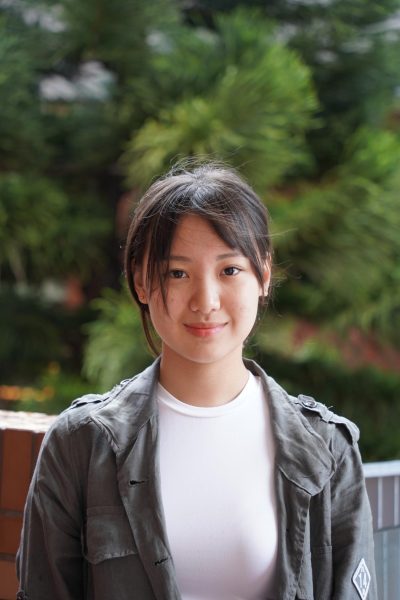Literary Fiction
With a bright yellow cover, a striking Angel of Death graphic and bold printed words spelling out “Martyr!,” Kaveh Akbar’s book had originally caught my eye in the corner of the Upper School Information Commons’ (USIC) bookshelves. With exams finally over, I settled into winter break certain that “Martyr!,” paired with hot cocoa and Christmas music, would be my ideal form of relaxation.
Sadly, “Martyr!” was not a fun read. It certainly didn’t align with the warm, festive joys of winter break. I would compare it to a devastatingly sad film: one that you truly adore, but can never watch again for the sake of your own happiness.
Akhbar immerses his reader into two fractured worlds: Cyrus’ rootless existence in 2000s America as a recovering alcoholic and poet, with frequent flashbacks to his parents’ violent struggles in 1980s revolutionary Iran. After losing his mother in the 1988 United States (US) missile strike on Iran Air Flight 655 and watching his father slowly die from grueling years of labor, Cyrus becomes consumed with the idea of martyrdom. When Cyrus speaks with Orkideh, a peculiar Iranian-American artist facing terminal cancer, he finds meaning in the endurance of living rather than the sacrifice of dying.
Throughout the book, I was captivated by the vivid descriptions of remarkable stories from Iranian history, intertwined with Cyrus’ intimate, unraveling grief. As I raced toward the end of the book to uncover the haunting mystery of Orkideh’s purpose, I found myself lost in Kaveh Akbar’s intricate imagery and evocative symbolism. The Angel of Death—embodied by Cyrus’s uncle— emerges as a significant wartime symbol that eases soldiers’ final moments and pained cries with poetry and prayer. His ghost drives Cyrus into an obsessive spiral, endlessly questioning whether death carries meaning or only chaos. Clearly, the constant anecdotes of trauma and pain demand the reader to take constant breaks when reading. With little humor to balance it out, you can’t help but feel a deep ache for Cyrus’ grief.
I recommend this book for readers who are drawn to a powerful storytelling that interweaves a personal narrative with a rich historical context. However, for readers seeking lighthearted relaxation, I personally found that a comedy or fantasy novel paired much better with my warm blanket and cinnamon candle.
Self-help
Dubbed “a supremely practical and useful book” by New York Times bestselling author Mark Manson, “Atomic Habits” has quickly become a household name in the world of self-help literature, selling over 20 million copies worldwide. Written by James Clear, one of the world’s leading experts on habit formation, it has revolutionized the path to establishing effective routines.
When I first bought “Atomic Habits,” I will admit I was skeptical. Even after hearing countless rave reviews on various social media platforms about it, I still had doubts about how a book could actually explain the secrets to creating good habits that last and breaking bad ones. I was also uncertain about Clear’s claim of how simple changes could lead to huge results.
However, I was quickly proven wrong.
He introduces the four laws of behavior change: make it obvious, make it attractive, make it easy and make it satisfying. He also outlines easy steps to implement these laws, writing about habit stacking, the Two-Minute Rule and many more strategies. In habit stacking, you pair a new habit with an existing one, making routines easier to build. For example, if someone exercises daily, they could add the habit of stretching right after a workout, making the exercise the trigger of the new habit.
The book is organized around theories of habit formation, often supported by data from studies, then switches over to simple changes that can be easily added to lives. He also encloses many real-world examples of athletes, entrepreneurs and teachers, and provides downloadable templates for the strategies he discusses, which are available from his website.
Unlike many self-help books, “Atomic Habits” avoids being overly theoretical. His advice is straightforward and accessible, making it easier for readers to integrate into daily routines and it has shown me simple steps I can take to make my habits stick. Overall, I would say this is a great read for anyone looking to build solid habits that allow them to become a little better every day.
Psychological Fiction
“The Bell Jar” by Sylvia Plath, initially published in 1963 under the pseudonym Victoria Lucas due to its highly personal elements, had long been in my “to-read” list before I finally got to it. This book is acclaimed for being unfiltered in its exploration of women’s mental health in an era where their mental health was neglected and female characters in literature often lacked depth. As it rose to popularity in the 70s, “The Bell Jar” was embraced by second-wave feminists and gained a reputation as classic feminist literature.
The novel centers around a female protagonist, Esther Greenwood, a talented young woman whose mental health slowly unravels as she fails to create a personal identity in the deeply patriarchal and misogynistic society of the 50s. The tragic and unfortunately semi-autobiographical elements of the book, such as mental deterioration, became all the more prevalent when Sylvia Plath committed suicide 28 days after the first edition of her book was released in the UK.
Knowing this, as I finally worked up the courage to begin reading, I braced myself for a soul-wrecking and almost depression-inducing experience. Surprisingly, this esteemed novel fell short of my expectations.
It was much more interesting than most other books. But to me, reading it was like watching someone scream from the other side of a glass screen. I could see the events of the book, as well as Esther’s emotional responses; however, I couldn’t hear it the same way other readers seemed to. I didn’t understand her character or decisions and felt disconnected from the themes presented in the book: mental illness, gender and alienation. After going online and reading reviews from some other readers, I realized that the reason for this was because I lack personal experience in mental health issues. I didn’t get the message of the book, but instead I learned that serious mental illness could seem insignificant or irrational to those simply observing from the outside.
Despite how I wasn’t able to connect with the novel, “The Bell Jar” could be a very relatable read for others, and those who suffer from mental health issues may be able to resonate with Esther especially deeply. Although I personally prefer novels such as “The Stranger” and “The Metamorphosis,” “The Bell Jar” is still an intriguing read that I would recommend to others. I actually plan to re-read the novel to try and understand it better.

![[PHOTO COURTESY OF PENGUIN RANDOM HOUSE, PENGUIN BOOKS, PENGUIN BOOKSHOP]](https://blueandgoldonline.org/wp-content/uploads/2025/05/books-1200x675.png)
![[PHOTO COURTESY OF GOODREADS]](https://blueandgoldonline.org/wp-content/uploads/2025/09/Untitled-design-1-e1759063850793-1200x466.png)
![[PHOTO COURTESY OF WARNER BROS.]](https://blueandgoldonline.org/wp-content/uploads/2025/09/SPRMAN_Character_Art_Superman_Instavert_1638x2048_DOM-960x1200.webp)
![[PHOTO COURTESY OF SCOTT YAMANO]](https://blueandgoldonline.org/wp-content/uploads/2025/09/e608ae29-be1a-4440-9730-acb2d1438555_7200x4800-1200x800.jpg)
![[PHOTO COURTESY OF APPLE TV+]](https://blueandgoldonline.org/wp-content/uploads/2025/09/rev-1-F1-FPJK-0009_High_Res_JPEG-1200x633.webp)
![A large "Coulda Been Love" sign in front of the show set. [PHOTO COURTESY OF DRUSKI'S COULDA BEEN LOVE SHOW]](https://blueandgoldonline.org/wp-content/uploads/2025/05/IMG_1877-1200x678.jpeg)
![[PHOTO COURTESY OF IMDB]](https://blueandgoldonline.org/wp-content/uploads/2025/05/Untitled-design-2.png)


